Experimental and Numerical Investigation of the Non-Reacting Flow in a High-Fidelity Heavy-Duty Gas Turbine DLN Combustor
Abstract
Highlights
- ⮚
- A dry low NOx combustor for a heavy-duty gas turbine using lean premixed technology was studied, and a high-fidelity test model was built.
- ⮚
- PIV technology was applied to measure the cold flow field in the high-fidelity test model.
- ⮚
- Multi-nozzle coupling phenomena inside the DLN combustor chamber were analyzed based on the experimental and numerical results.
1. Introduction
2. Materials and Methods
2.1. The High-Fidelity DLN Combustor Test Model for a Heavy-Duty Gas Turbine
2.2. PIV Measurement Scheme
2.3. Auxiliary Systems
2.4. Numerical Method
3. Results and Discussion
3.1. Cross-Section Measurement Results and Analysis
- (1)
- The two clockwise flows merged with the respective surrounding counterclockwise flows, forming a structure of two central symmetrical flows.
- (2)
- The flow pattern of each cross-section in the combustion chamber was self-similar under different working conditions, which means the increase in air mass flow only resulted in the increase in the absolute velocity without changing the flow trend in each section.
- (3)
- The flow inside the combustion chamber was constantly rotating counterclockwise.
- (4)
- The swirling velocity was gradually dissipating.
3.2. Longitudinal Section Measurement Results and Analysis
3.3. CFD Results and Analysis
4. Conclusions
Author Contributions
Funding
Conflicts of Interest
References
- Venkataraman, K.; Lewis, S.E.; Natarajan, J.; Thomas, S.R.; Citeno, J.V. F-Class DLN technology advancements: DLN2.6+. Proc. ASME Turbo Expo 2011, 2012, GT2011-45373. [Google Scholar]
- Nemitallah, M.A.; Rashwan, S.S.; Mansir, I.B.; Abdelhafez, A.A.; Habib, M.A.M. Review of novel combustion techniques for clean power production in gas turbine. Energy Fuels 2018, 32, 979–1004. [Google Scholar] [CrossRef]
- Lefebvre, A.H.; Ballal, D.R. Gas Turbine Combustion: Alternative Fuels and Emissions, 3rd ed.; CRC Press: Boca Raton, FL, USA, 2010. [Google Scholar]
- Altay, H.M.; Hudgins, D.E.; Speth, R.; Annaswamy, A.M.; Ghoniem, A.F. Mitigation of thermoacoustic instability utilizing steady aisr injection near the flame anchoring zone. Combust. Flame 2010, 157, 686–700. [Google Scholar] [CrossRef]
- Davis, L.B.; Black, S.H. Dry low NOx combustion systems for GE heavy-duty gas turbines. In Proceedings of the Power-Gen America 95: Power Generation Conference, Anaheim, CA, USA, 5–7 December 1995. [Google Scholar]
- Weber, R.; Dugul, J. Combustion accelerated swirling flows in high confinements. Prog. Energy Combust. Sci. 1992, 18, 349–367. [Google Scholar] [CrossRef]
- Lucca-Negro, O.; O’Doherty, T. Vortex breakdown: A review. Prog. Energy Combust. Sci. 2001, 27, 431–481. [Google Scholar] [CrossRef]
- Berrino, M.; Lengani, D.; Satta, F.; Ubaldi, M.; Zunino, P.; Colantuoni, S.; Di Martino, P. Investigation of the dynamics of an ultra low NOx injection system by pod data post-processing. In Proceedings of the ASME Turbo Expo 2015, Montreal, QC, Canada, 15–19 June 2015. [Google Scholar]
- Boyce, M.P. Advanced industrial gas turbine for power generation. In Combined Cycle Systems for Near-Zero Emission Power Generation, 1st ed.; Rao, A.D., Ed.; Woodhead Publishing: Sawston, UK, 2012. [Google Scholar]
- Chong, C.T.; Hochgreb, S. Measurements of non-reacting and reacting flow fields of a liquid swirl flame burner. Chin. J. Mech. Eng. 2015, 28, 394–401. (In Chinese) [Google Scholar] [CrossRef]
- Khalil, A.E.; Brooks, J.M.; Gupta, A.K. Impact of confinement on flowfield of swirl flow burners. Fuel 2016, 184, 1–9. [Google Scholar] [CrossRef]
- Orbay, R.C.; Nogenmyr, K.J.; Klingmann, J.; Bai, X.S. Swirling turbulent flows in a combustion chamber with and without heat release. Fuel 2013, 104, 133–146. [Google Scholar] [CrossRef]
- Johnson, M.; Littlejohn, D.; Nazeer, W.; Smith, K.; Cheng, R. A comparison of the flowfields and emissions of high-swirl injectors and low-swirl injectors for lean premixed gas turbines. Proc. Combust. Inst. 2005, 30, 2867–2874. [Google Scholar] [CrossRef]
- Strakey, P.A.; Yip, M.J. Experimental and numerical investigation of a swirl stabilized premixed combustor under cold-flow conditions. J. Fluids Eng. 2007, 129, 942–953. [Google Scholar] [CrossRef]
- Reichling, G.; Noll, B.; Aigner, M. Numerical simulation of the non-reactive and reactive flow in a swirled model gas turbine combustor. In Proceedings of the 21st AIAA Computational Fluid Dynamics Conference, American Institute of Aeronautics and Astronautics, San Diego, CA, USA, 24–27 June 2013. [Google Scholar]
- Gomez-Ramirez, D.; Kedukodi, S.; Gadiraju, S.; Ekkad, S.V.; Moon, H.-K.; Kim, Y.; Srinivasan, R. Gas turbine combustor rig development and initial observations at cold and reacting flow conditions. In Proceedings of the ASME Turbo Expo 2016: Turbomachinery Technical Conference and Exposition, American Society of Mechanical Engineers, Seoul, Republic of Korea, 13–17 June 2016. [Google Scholar]
- Park, S.; Gomez-Ramirez, D.; Gadiraju, S.; Kedukodi, S.; Ekkad, S.V.; Moon, H.K.; Kim, Y.; Srinivasan, R. Flow field and wall temperature measurements for reacting flow in a lean premixed swirl stabilized can combustor. J. Eng. Gas Turbines Power 2018, 140, 091503. [Google Scholar] [CrossRef]
- Pareja, J.; Lipkowicz, T.; Inanc, E.; Carter, C.D.; Kempf, A.; Boxx, I. An experimental/numerical investigation of non-reacting turbulent flow in a piloted premixed Bunsen burner. Exp. Fluids 2022, 63, 33. [Google Scholar] [CrossRef] [PubMed]
- Sun, F.; Suo, J.; Liu, Z. Effect of the swirl intensity on the non-reacting flowfields and fuel-air premixing characteristics for lean premixed combustors. J. Mech. Sci. Technol. 2022, 36, 433–444. [Google Scholar] [CrossRef]
- Twarog, K.; Mannaa, O.; Sung, C.J.; Mongia, H.C. On integrated experimentation and simulation of a counter-turning swirling mixer, part I: Experimentation. Aerosp. Sci. Technol. 2021, 119, 107186. [Google Scholar] [CrossRef]
- Sharaborin, D.K.; Savitskii, A.G.; Bakharev, G.Y.; Lobasov, A.S.; Chikishev, L.M.; Dulin, V.M. PIV/PLIF investigation of unsteady turbulent flow and mixing behind a model gas turbine combustor. Exp. Fluids 2021, 62, 96. [Google Scholar] [CrossRef]
- Cordier, M.; Vandel, A.; Renou, B.; Cabot, G.; Boukhalfa, M.A.; Esclapez, L.; Barré, D.; Riber, E.; Cuenot, B.; Gicquel, L. Experimental and numerical analysis of an ignition sequence in a multiple-injectors burner. In Proceedings of the ASME Turbo Expo 2013: Turbine Technical Conference and Exposition, San Antonio, TX, USA, 3–7 June 2013. [Google Scholar]
- Worth, N.A.; Dawson, J.R. Modal dynamics of self-excited azimuthal instabilities in an annular combustion chamber. Combust. Flame 2013, 160, 2476–2489. [Google Scholar] [CrossRef]
- Kao, Y.H.; Tambe, S.B.; Jeng, S.M. Aerodynamics study of a linearly-arranged 5-Swirler array. ASME Turbo Expo 2014: Turbine Technical Conference and Exposition. Am. Soc. Mech. Eng. 2014, 45684, GT2014-25094. [Google Scholar]
- Cho, C.H.; Sohn, C.H.; Cho, J.H.; Kim, H.S. Effects of burner interaction on NOx Emission from swirl premix burner in a gas turbine combustor. ASME Turbo Expo 2014: Turbine Technical Conference and Exposition. Am. Soc. Mech. Eng. 2014, 45691, GT2014-26174. [Google Scholar]
- Staffelbach, G.; Gicquel, L.; Boudier, G.; Poinsot, T. Large eddy simulation of self-excited azimuthal modes in annular combustors. Proc. Combust. Inst. 2009, 32, 2909–2916. [Google Scholar] [CrossRef]
- Dolan, B.J.; Villalva Gomez, R.; Nawroth, H.; Pack, S.; Gutmark, E.J. Study on the isothermal flowfields of interacting swirl-stabilized nozzles. In Proceedings of the 53rd AIAA Aerospace Sciences Meeting, Kissimmee, FL, USA, 5–9 January 2015. [Google Scholar]
- Grant, I. Particle image velocimetry: A review. Proceedings of the Institution of Mechanical Engineers, Part C. J. Mech. Eng. Sci. 1997, 211, 55–76. [Google Scholar] [CrossRef]
- Brend, M.A.; Denman, P.A.; Carrotte, J.F. Volumetric PIV measurement for capturing the port flow characteristics within annular gas turbine combustors. Exp. Fluids 2020, 61, 106. [Google Scholar] [CrossRef]






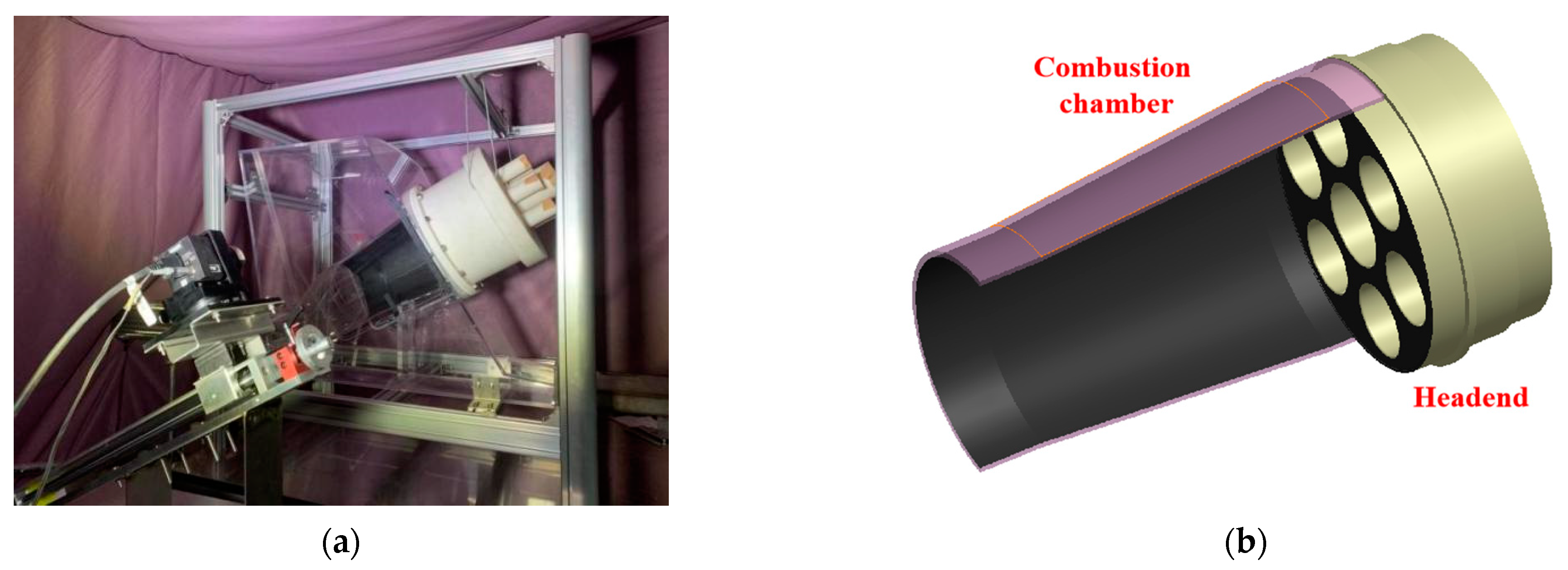

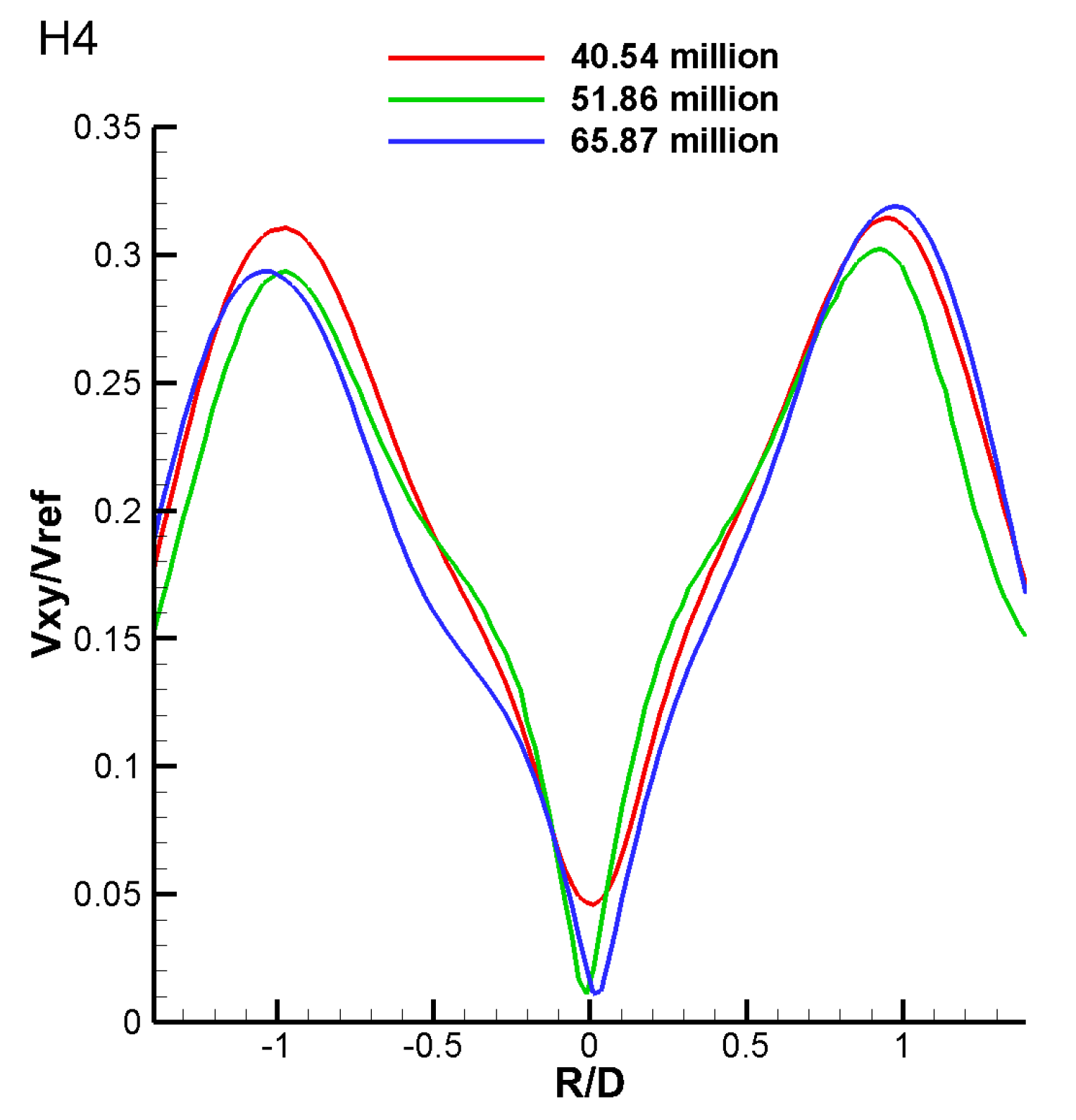
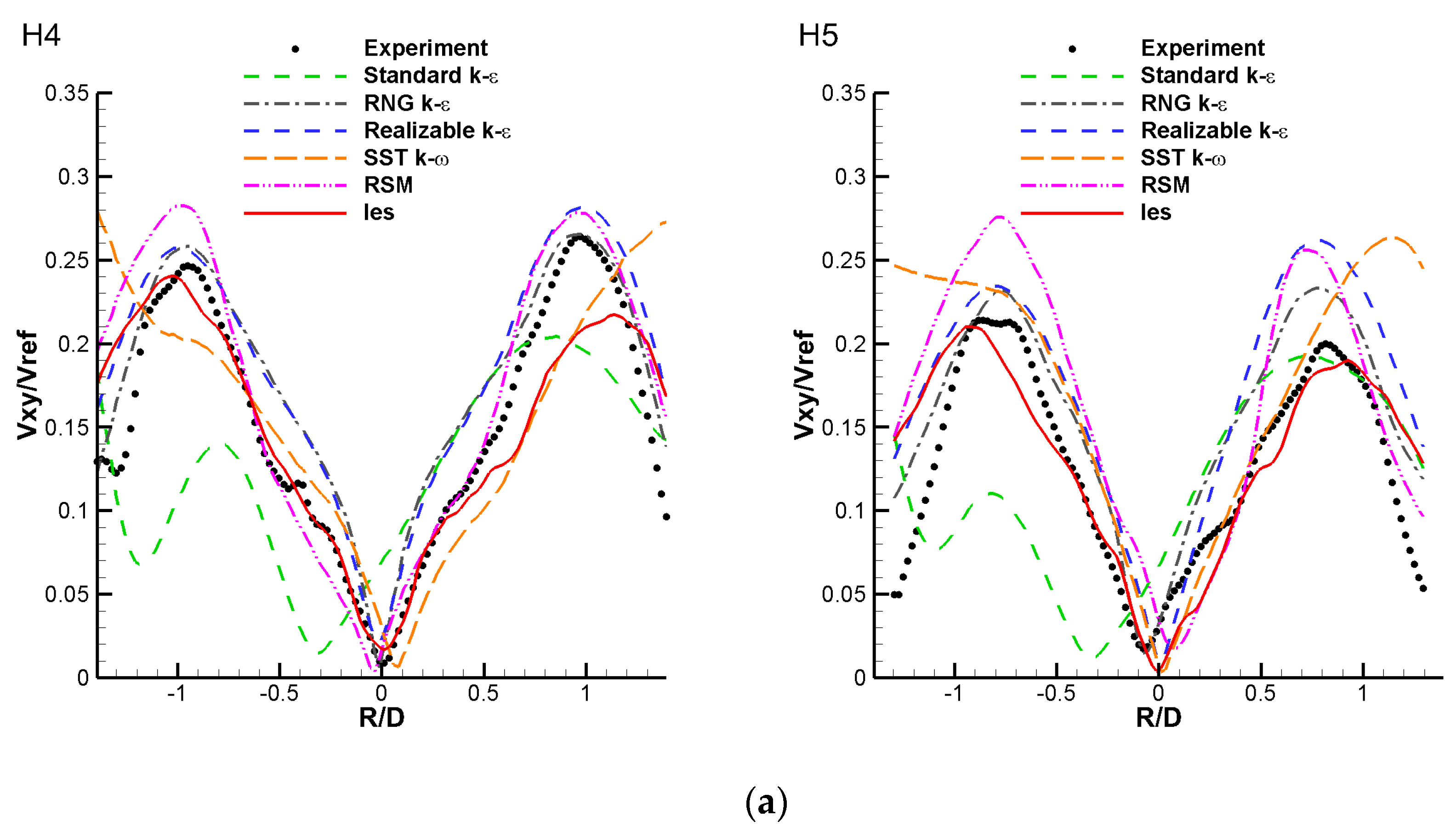





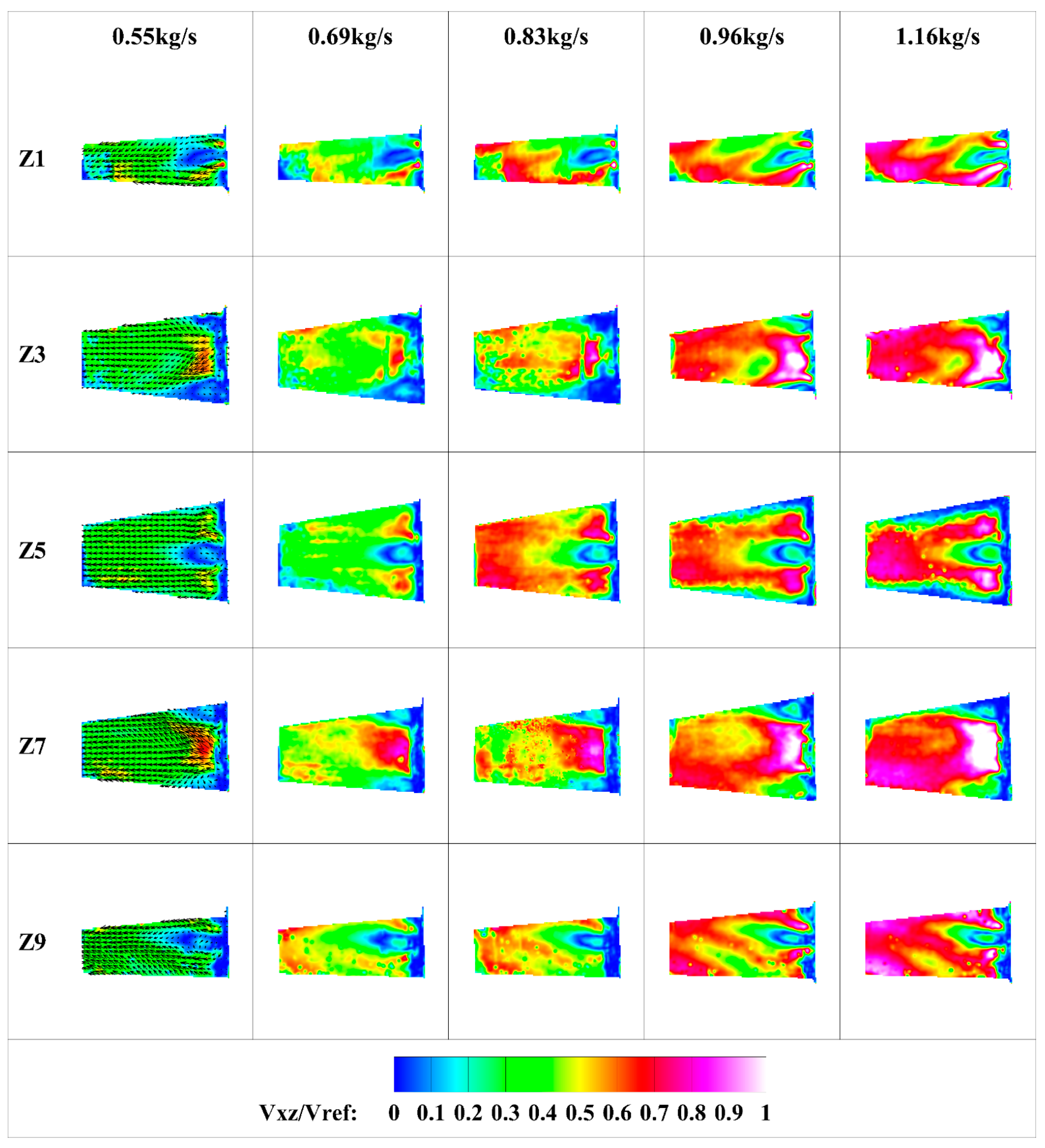



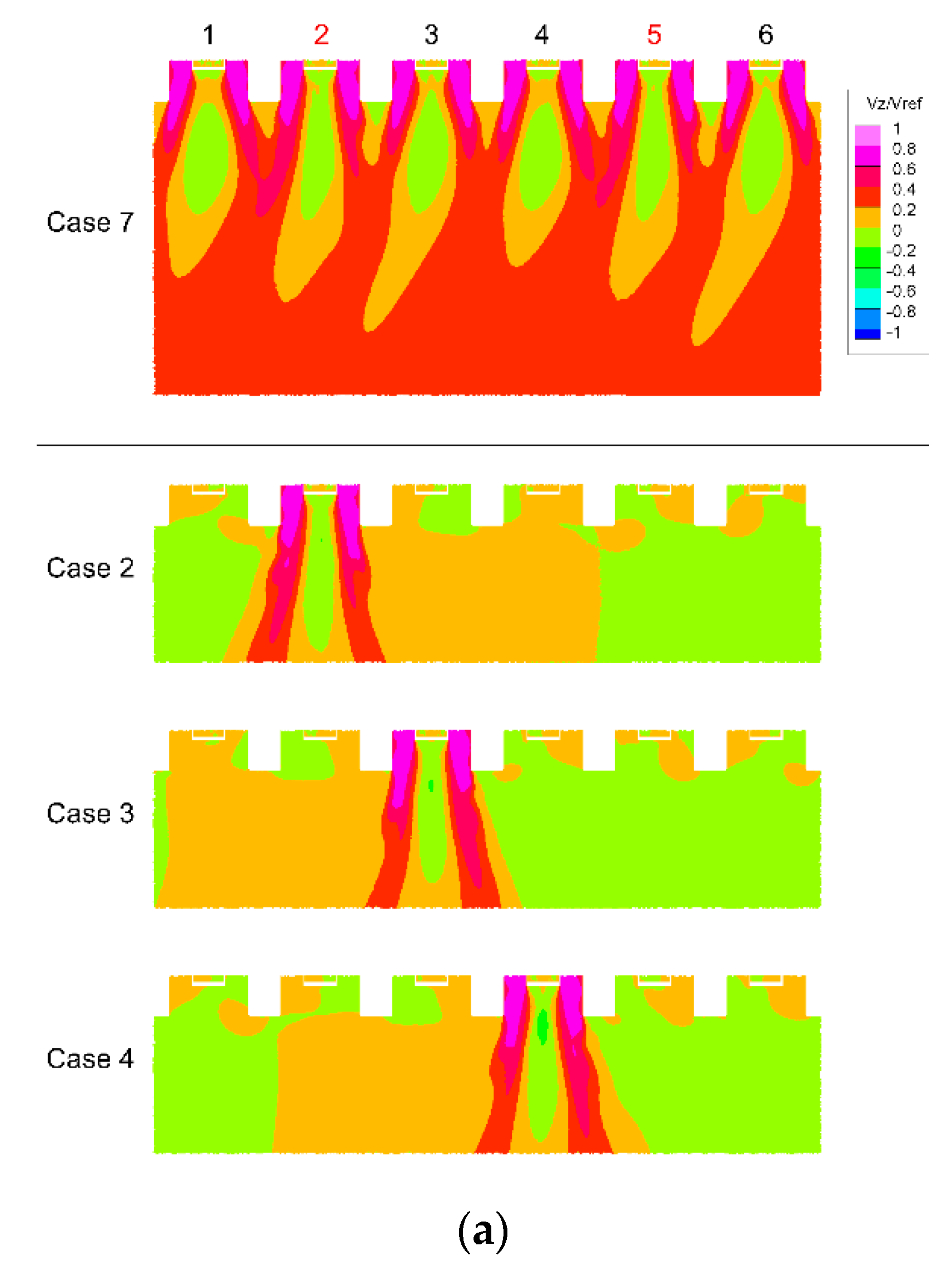
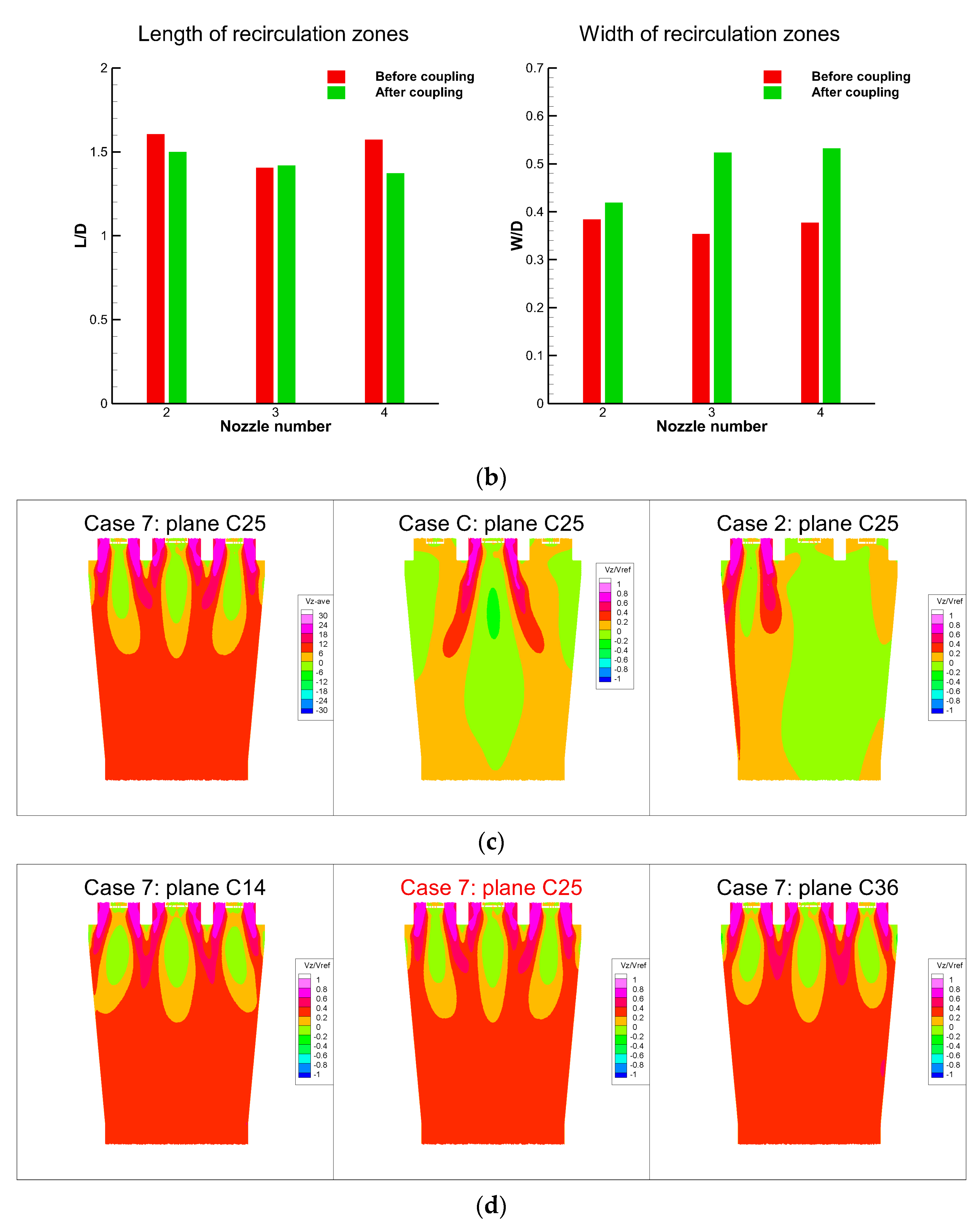
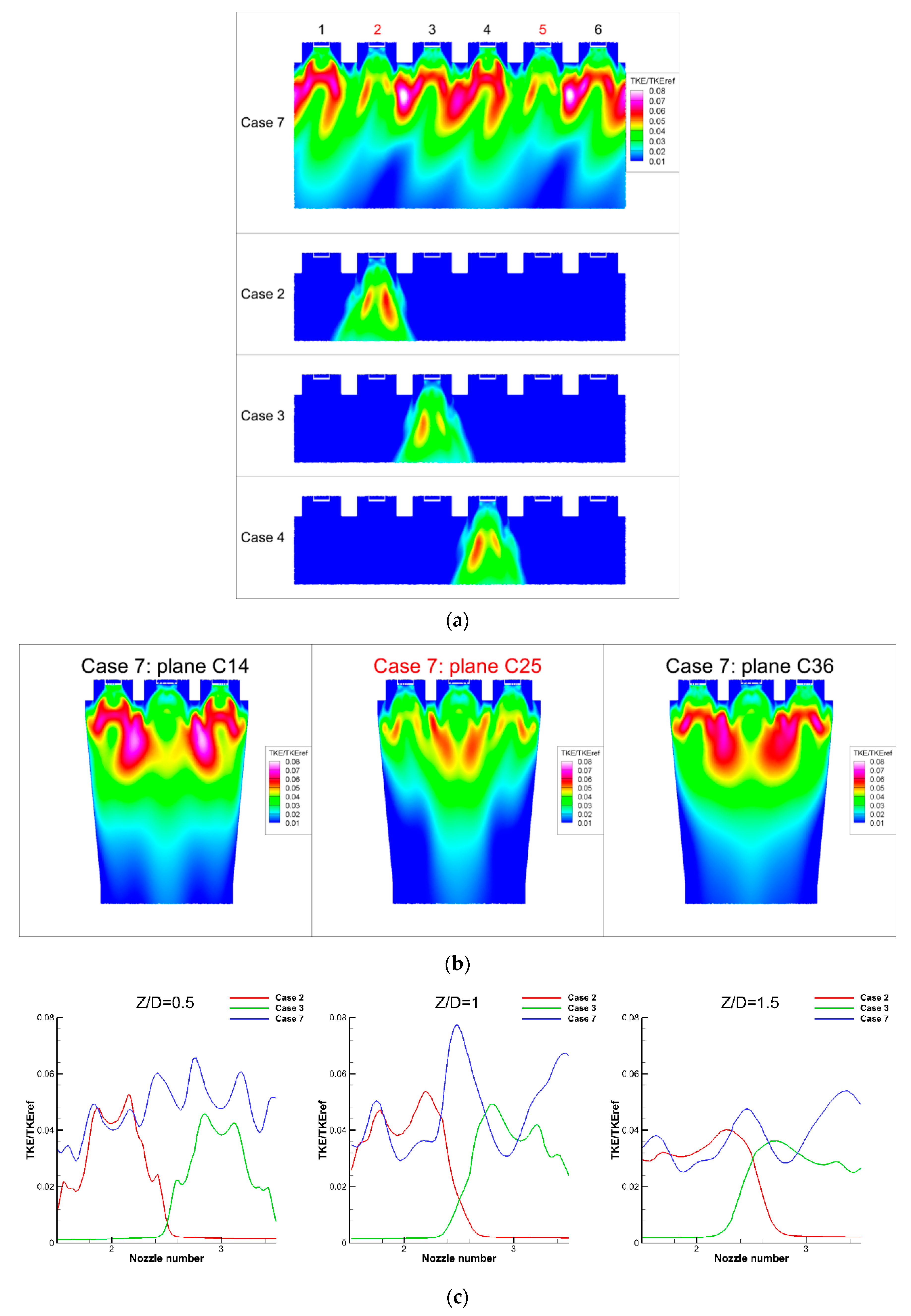
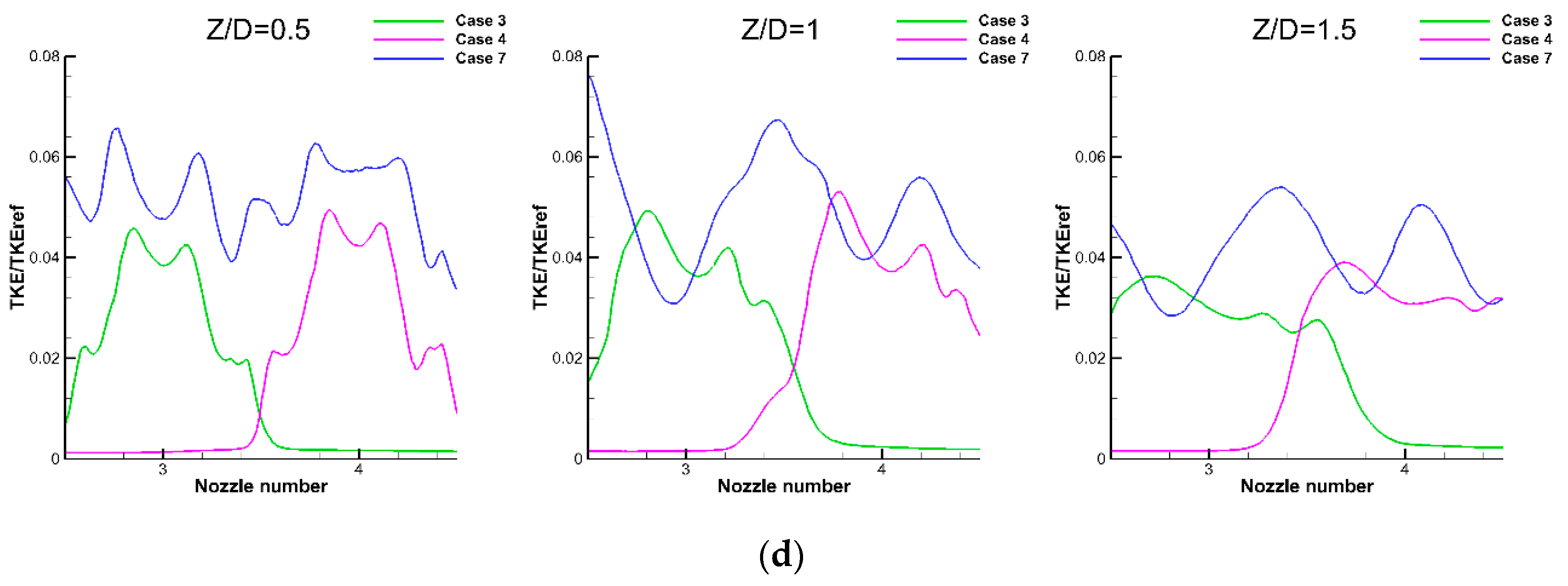
| Nozzle Number | 1 | 2 | 3 | 4 | 5 | 6 | C |
|---|---|---|---|---|---|---|---|
| Mass ratio(%) | 13.82 | 14.41 | 13.56 | 14.28 | 13.74 | 14.18 | 15.40 |
| Deviation from the surrounding nozzle average(%) | −1.25 | 2.94 | −3.10 | 1.98 | −1.86 | 1.29 | 9.99 |
| Case Name | Description |
|---|---|
| Case 2 | Only nozzle 2 is opened |
| Case 3 | Only nozzle 3 is opened |
| Case 4 | Only nozzle 4 is opened |
| Case C | Only the central nozzle is opened |
| Case 7 | All nozzles are opened |
Publisher’s Note: MDPI stays neutral with regard to jurisdictional claims in published maps and institutional affiliations. |
© 2022 by the authors. Licensee MDPI, Basel, Switzerland. This article is an open access article distributed under the terms and conditions of the Creative Commons Attribution (CC BY) license (https://creativecommons.org/licenses/by/4.0/).
Share and Cite
Feng, Y.; Li, X.; Ren, X.; Gu, C.; Lv, X.; Li, S.; Wang, Z. Experimental and Numerical Investigation of the Non-Reacting Flow in a High-Fidelity Heavy-Duty Gas Turbine DLN Combustor. Energies 2022, 15, 9551. https://doi.org/10.3390/en15249551
Feng Y, Li X, Ren X, Gu C, Lv X, Li S, Wang Z. Experimental and Numerical Investigation of the Non-Reacting Flow in a High-Fidelity Heavy-Duty Gas Turbine DLN Combustor. Energies. 2022; 15(24):9551. https://doi.org/10.3390/en15249551
Chicago/Turabian StyleFeng, Yuan, Xuesong Li, Xiaodong Ren, Chunwei Gu, Xuan Lv, Shanshan Li, and Ziye Wang. 2022. "Experimental and Numerical Investigation of the Non-Reacting Flow in a High-Fidelity Heavy-Duty Gas Turbine DLN Combustor" Energies 15, no. 24: 9551. https://doi.org/10.3390/en15249551
APA StyleFeng, Y., Li, X., Ren, X., Gu, C., Lv, X., Li, S., & Wang, Z. (2022). Experimental and Numerical Investigation of the Non-Reacting Flow in a High-Fidelity Heavy-Duty Gas Turbine DLN Combustor. Energies, 15(24), 9551. https://doi.org/10.3390/en15249551







